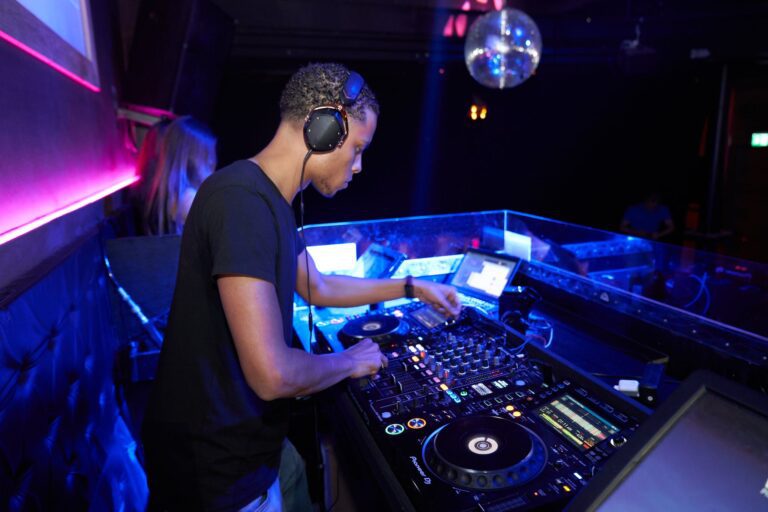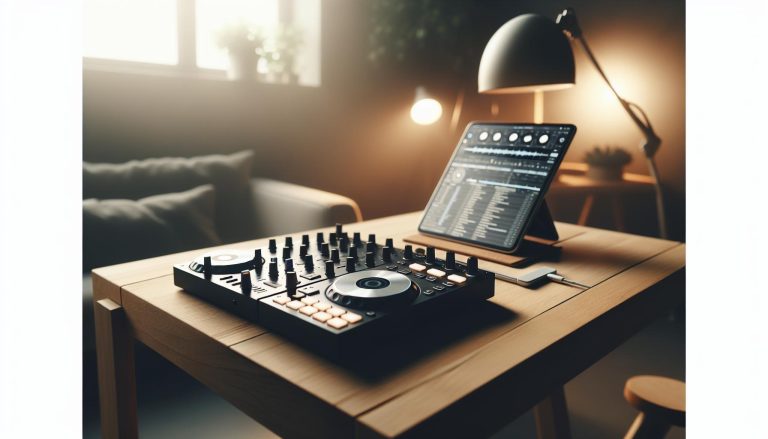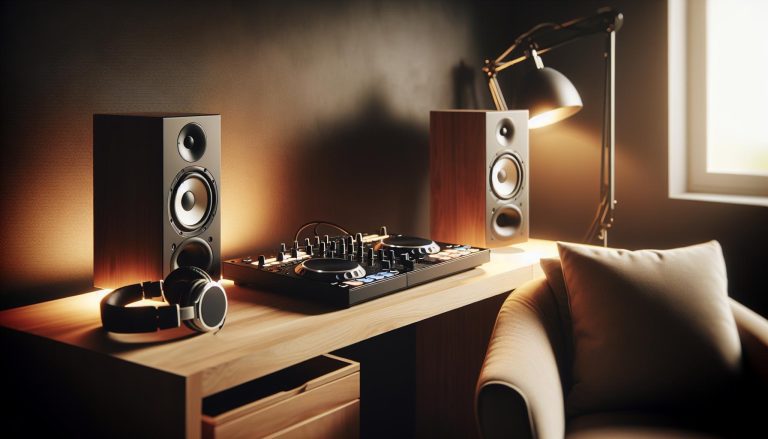How to become a World-Class DJ
Table of ContInnehållsförteckning
- 1. Introduction to DJing
- 1.1 The History of DJing
- 1.2 Understanding Different Types of DJs
- 1.3 The Evolution of Technology in DJing
- 2. Utrustningsgrunder
- 2.1 DJ-kontrollers vs. skivspelare vs. CDJs
- 2.2 Hörlurarnas betydelse
- 2.3 Att sätta upp din DJ-bås
- 3. Musikval och kuratering
- 3.1 Identifying Your Unique Sound
- 3.2 Building a Versatile Music Library
- 3.3 Understanding Different Genres and Styles
- 4. Mixningstekniker
- 4.1 Grunderna i beatmatching
- 4.2 Övergångstekniker: crossfading och cutting
- 4.3 Creative Use of Effects and Loops
- 5. Läsa av publiken
- 5.1 Understanding Crowd Dynamics
- 5.2 Techniques for Engaging the Crowd
- 5.3 Göra justeringar i realtid under setet
- 6. Scenframträdande och färdigheter
- 6.1 Stage Presence and Confidence
- 6.2 Interacting with the Crowd
- 6.3 Creating a Memorable Show
- 7. Inspelning och produktion
- 7.1 Basics of Music Production Software
- 7.2 Creating Your First Mix
- 7.3 Understanding Mastering and Finalizing
- 8. Att bygga sitt DJ-varumärke
- 8.1 Creating Your DJ Persona
- 8.2 Designing a Striking Logo
- 8.3 Building a Strong Online Presence
- 9. Marknadsföringsstrategier
- 9.1 Using Social Media Effectively
- 9.2 Building and Engaging a Fanbase
- 9.3 Networking with Other DJs and Industry Professionals
- 10. Boka spelningar och management
- 10.1 Finding Your First Gigs
- 10.2 Negotiating Contracts and Fees
- 10.3 Collaborating with Clubs and Promoters
- 11. DJ:andets affärssida
- 11.1 Managing Finances and Budget
- 11.2 Understanding Legal Aspects
- 11.3 Taxes and Filing for DJs
- 12. Kontinuerligt lärande och utveckling
- 12.1 Staying Updated with Trends and Technology
- 12.2 Attending Workshops and Masterclasses
- 12.3 Learning from Feedback and Reviews
- 13. Att balansera livet och DJ:andet
- 13.1 Time Management for Aspiring DJs
- 13.2 Building Relationships Outside of Music
- 13.3 Keeping Motivation and Inspiration Alive
- 14. DJ:andets framtid
- 14.1 Upcoming Trends to Watch
- 14.2 Artificial Intelligence in Music
- 14.3 Building a Sustainable DJ Career
- 15. Resurser och verktyg
- 15.1 Recommended Software and Apps
- 15.2 Explore Online Communities and Forums
- 15.3 Essential Books and Listening Tips
Introduction to DJing
1.1 The History of DJing
The journey of DJing begins in the colorful disco era of the late 1970s. Clubs were packed with people dancing all night long, while DJs became the superheroes of the dance floor. With two copies of the same vinyl and a pair of turntables, they could seamlessly blend tracks and keep the energy alive.
As the 1980s came, new technology, such as mixers with EQ and the rise of hip-hop culture, gave DJs more creative tools. Scratch techniques emerged, with pioneers like Grandmaster Flash transforming DJing into a performance art.
The 1990s and early 2000s brought the explosion of electronic dance music. Raves became a global phenomenon, and DJing became more about creating experiences than just playing records. Digital DJ software and laptops made it accessible to almost anyone.
Today, DJing blends genres, live mixes, and sampling, making it more diverse than ever. DJs are everywhere — in clubs, at festivals, and even in living rooms — proving that the love of music is timeless.
Throughout the decades, several key figures have left their mark on DJ culture, shaping it into what it is today. One of the earliest icons was Kool Herc, often called the father of hip-hop DJing. He laid the foundation by using two turntables to extend the instrumental breaks of songs, which sent the crowd into a frenzy. Then came Frankie Knuckles, the godfather of house music, who turned Chicago into a global epicenter of dance music. During the 1990s and 2000s, names like Carl Cox and Tiësto brought DJing into the mainstream, proving that DJs could be superstars in their own right. We also can’t forget the female pioneers like Annie Mac and DJ Jess, who broke barriers in a male-dominated scene and proved that the turntables are for everyone. Today, artists like Calvin Harris and Skrillex continue to shape the industry, using social media to connect with fans and redefine what it means to be a DJ. These pioneers have inspired countless people to pick up a pair of headphones, step up to the decks, and create their own rhythm in the world of DJing.
If you’re eager to enter this exciting world, remember that the best way to learn is by doing. Explore different genres, experiment with your mixes, and find what resonates with you and your audience. Get involved in the local music scene, find like-minded people, and share your passion. And most importantly, being a great DJ isn’t about the gear you have, but about your ability to convey emotion through music.
1.2 Understanding Different Types of DJs
DJs come in all shapes and styles, each with a unique energy and imprint. Let’s start with club DJs —the ones who get the party going and keep the dance floor alive all night. They set the mood through carefully chosen tracks, often in nightclubs and dance venues where the energy is electric. Think of them as the architects of the party; they do more than play music—they build an experience and can read the crowd like an open book. If you’ve ever felt the bass thump in your chest on a club floor, that’s the club DJ creating that magic.
Next are mobile DJs, also called event or party DJs. They’re the versatile chameleons of the DJ world, playing weddings, corporate events, and birthday parties. Their music libraries often span everything from classics to current hits, letting them adapt to all ages and tastes. Mobile DJs aren’t just musicians; they’re hosts and entertainers, often the ones who get everyone, from grandma to the kids, dancing. Every gig becomes a fresh canvas for their creativity, where they can add their personal touch—maybe playful moments on the mic or unexpected song choices that get guests singing along.
Then we have radio DJs —the ones who fill our everyday lives with music and company. They often combine music with personality, stories, interviews, or fun facts about the tracks they play. Think of them as musical guides who help us discover new artists or rediscover old favorites.
Each type of DJ has its role, adding flavor to the music scene and keeping life’s rhythm going—whether that’s in a packed club, a living room, or a busy office.
Getting started as a DJ is about finding your own style and letting your personality shine through. Try different genres and weave in your favorites. The most important tip? Have fun. The energy you bring is contagious and makes your performances truly unforgettable.
1.3 The Evolution of Technology in DJing
Think back to the golden age of music when vinyl records dominated. DJs carried around heavy crates of records and mastered the art of mixing with millimeter precision. When cassette tapes came along, it became easier to transport music, but the real technological shift arrived with CDs in the 1980s and 1990s. With two CD players and a mixer, DJs could deliver cleaner sound and switch tracks faster—almost like magic!
At the end of the ’90s and beginning of the 2000s came the next revolution: digital DJ software like Serato and Traktor. Suddenly, an entire music library could fit on a USB stick or a laptop. Together with the development of MIDI controllers , DJs gained completely new tools for remixing and experimenting live.
This technological journey also transformed the role of the DJ. DJs went from being “record players” to becoming live artists. With today’s software, DJs can manipulate sound, add effects, create mashups, and even sync with visual elements such as lighting and video projections. The audience’s experience has become more interactive than ever before.
At the same time, accessibility has increased dramatically. Nowadays, you no longer need turntables or hundreds of vinyl records to get started. A laptop, a controller, and a pair of headphones are enough to begin. Platforms like SoundCloud and Mixcloud make it easy to share your mixes with the world, while online communities offer tips, tricks, and feedback.
So, if you’re thinking about starting out as a DJ, don’t focus too much on the technology. What matters most is the music you love and how you choose to share it with others. Whether you’re mixing from a laptop or an old-school vinyl setup, the important thing is to let the music take over!
2. Essential DJ Equipment
2.1 DJ Controllers vs. Turntables vs. CDJs
When you step into the world of DJing, the gear you choose is crucial for both your development and your sound. Let’s take a look at the three most common options: DJ controllers, turntables, and CDJs.
DJ controllers are compact and versatile, allowing you to mix digitally straight from your laptop. They usually come with built-in sound cards and pads for triggering samples and loops. Controllers are often budget-friendly, portable, and perfect for beginners who want to get started quickly.
Turntables are for vinyl lovers. They offer a tactile feel that many DJs still prefer, especially when it comes to scratching and old-school mixing. The warm sound of vinyl is hard to beat and gives a classic DJ vibe that audiences often appreciate.
So how do you choose? It’s all about style and goals:
💡 Tip: Try different setups in a music store or with a DJ friend before deciding. It’s as much about the feel as it is about the features.
2.2 Hörlurarnas betydelse
Good headphones are one of the DJ’s most important tools—without them, it’s nearly impossible to mix precisely. They help you hear details in the music that easily get lost in club speakers with heavy bass.
When choosing DJ headphones, think about:
A smart tip is to always test headphones with music you know well. That way, you can instantly hear whether the sound is reproduced in a way that suits you.
Remember: headphones aren’t a luxury—they’re a necessity if you want to deliver a tight and energetic set. för att du ska kunna leverera en tajt och energisk spelning.
2.3 Setting Up Your DJ Booth
Building your DJ booth is about both practical functionality and creating an inviting atmosphere.
⚡ ⚡ Cable management is also extremely important. Nothing looks more unprofessional than a messy bundle of wires. Use cable ties, label your cables, and keep everything neat. It looks professional and saves you from panic if something needs fixing mid-set.
A well-organized booth = less stress and more focus on the music. And yes, it also makes you look cooler when you’re up there playing 😉
3. Music Selection and Curation
3.1 Identifying Your Unique Sound
Finding your musical identity is like mixing the perfect cocktail – the right ingredients create something unique and memorable. Start by exploring the music you love the most. Which tracks make you move? Write down your favorites and analyze: do they lean toward house, techno, hip-hop, or maybe disco? This will help you understand which elements resonate with you..
Your sound isn’t just about the music – it’s also part of your brand. How do you want the world to perceive you? Are you an energetic rave DJ or a laid-back sunset DJ? Create a moodboard with images, colors, and feelings that match your sound. This will be your creative compass.
Once you’ve found a direction – dare to mix genres. Try mashups and your own bootlegs. Imagine a house beat combined with soul vocals, or hip-hop rhythms layered under a pop hook. The more you experiment, the closer you’ll get to a recognizable and unique sound that becomes your signature.
3.2 Building a Versatile Music Library
A DJ without a diverse music library is like a chef without spices. You need variety to adapt to different crowds and situations.
A strong library includes:
Sources for building your collection:
Be curious! Try adding everything from jazz to afrobeats into your sets. The broader your library, the more opportunities you’ll have to create unforgettable moments for your audience.
3.3 Understanding Different Genres and Styles
Diving into different genres is like opening a treasure chest of sounds and emotions. Each genre has its own unique building blocks – beats, tempo, instruments, and themes.
Examples:
As a DJ, it’s important to learn the structure of each genre. When you understand their character, you’ll be better at combining them and creating a red thread throughout your sets.
And don’t be afraid to experiment: try laying a funk bassline under a rock vocal or an ambient synth over a hip-hop beat. It’s often in the unexpected combinations that the magic happens ✨
Remember – it’s not just about playing music. It’s about telling a story through sound , one the audience experiences together.
4. Mixing Techniques
4.1 The Basics of Beatmatching
Mastering beatmatching is like learning to ride a bike – difficult at first, but second nature once you’ve got the feel for it. Beatmatching is about syncing the tempo of two tracks so they flow together seamlessly. synka två låtars tempo så att de flyter ihop sömlöst.
Start by choosing two songs with similar BPM (beats per minute). Listen for the downbeats (often the kick drum) and use the pitch fader to adjust the tempo until both tracks match. When you succeed, you’ll get a transition that feels natural and keeps the dance floor moving.
A good way to practice is to build a training playlist with tracks you know work well together. It saves time and makes practice more enjoyable. Also, remember to train your ear – listen to rhythms, instruments, and small details. The better your ear becomes, the more intuitive your mixing will feel.
4.2 Transition Techniques: Crossfading and Cutting
Keeping the flow in a set comes down to smooth transitions. Two of the most common techniques are crossfading and cutting.
– Crossfading: This is when you slowly blend from one track into another. You lower the volume of the first track while raising the second. By adjusting the EQ (bass, mids, treble), you can make the transition even smoother. Crossfading is perfect when you want to build a wave of energy on the dance floor.
– Cutting: This is all about sharp, quick switches between songs. It’s often used to surprise the crowd or create a dramatic effect—like suddenly dropping a classic in the middle of a house set. Timing is key—switch right on the downbeat to keep the energy tight.
🎧 Tip: Record your practice sets and listen back afterwards. You’ll quickly hear which transitions work well and which ones need fine-tuning.
4.3 Creative Use of Effects and Loops
Effects and loops are the spices in your mix – they can transform a good set into an unforgettable experience.
– Effects like reverb, delay, and distortion can add depth and excitement to your mix. For example, a well-placed echo before a drop can build anticipation in the crowd.
– Loops can create new rhythms or give you time to prepare your next transition. A simple drum loop can keep the energy going while you line up the next track.
The key is balance – use effects to enhance, not overpower. The audience still wants to hear the songs they love, but with your personal twist.
Don’t be afraid to experiment! It’s often in the small, spontaneous ideas that you discover your unique style..
5. Reading the Crowd
5.1 Understanding Crowd Dynamics
One of the most important skills a DJ can have is the ability to read the crowd. It’s about sensing the energy in the room and adjusting your music accordingly. The audience constantly gives you signals: if the dance floor fills up, if people start leaving, if hands go up in the air – it’s all feedback on your track selection.
A great DJ is like a psychologist on the dance floor – analyzing the mood and steering the energy with music. Is the crowd a bit sluggish? Drop a hit everyone knows. Are they at their peak? Build on it with more intense beats.
5.2 Techniques for Engaging the Crowd
It’s not enough to just play music – you also need to create an experience. Here are a few techniques:
Remember: the crowd wants to feel like you’re playing for them, not just for yourself.
5.3 Making Real-Time Adjustments
No set ever goes exactly as planned. That’s why the ability to adapt in the moment is crucial. If the crowd isn’t responding to a certain genre – switch it up. If the energy is too high and people are starting to tire out – slow things down a bit and build back up.
Let your intuition and experience guide you. The more gigs you play, the better you’ll get at quickly sensing what works.
And remember: even if you’ve prepared a setlist, flexibility is key. The best DJs are the ones who can change the plan on the fly while still making it feel seamless and natural for the audience.
6. Stage Presence and Skills
6.1 Stage Presence and Confidence
Standing behind the decks is more than just playing music – it’s performing. Your stage presence shapes how the crowd perceives you and how much they engage with your set. Keep your head up, move with the music, and don’t be afraid to show that you’re enjoying yourself. Confidence is contagious. If you look comfortable and happy, the crowd will feel that same energy.
Tip: Practice in front of a mirror or record yourself to see how you perform. Small details like posture, eye contact, and movement can make a big difference.
6.2 Interacting with the Crowd
A great DJ is not only a musician but also a communicator. The crowd wants to feel like you’re with them, not just for them. Make eye contact, smile, reach out with your hands, and sometimes it can even be powerful to grab the mic and hype the energy.
Interaction is also about attentiveness. Notice if a certain track gets an extra-strong reaction? Build on that. See the energy dipping? Change direction. Show the audience that you see them and that you’re listening.
6.3 Creating a Memorable Show
Music is the core, but the whole surrounding experience is what makes a night unforgettable. Think about how you can create a complete experience::
Remember: people might not always recall exactly which tracks you played, but they’ll always remember how you made them feel..
7. Recording and Production
7.1 Basics of Music Production Software
For a DJ who wants to take the next step, it’s important to understand music production software (DAWs – Digital Audio Workstations). Programs like Ableton Live, FL Studio, and Logic Pro give you the tools not only to mix music but also to create your own beats, remixes, and original productions.
A DAW works like a digital studio: you can import sounds, apply effects, record instruments or vocals, and build entire tracks from scratch. Learning the basics – such as track management, looping, and effects – gives you the opportunity to develop a unique sound that sets you apart as a DJ.
7.2 Creating Your First Mix
Playing live is one thing – but recording your egen mix own mix opens up entirely new opportunities. A mix can be used to market yourself, showcase your style to promoters, or share with fans online.
💡 Tips for your first mix:
Once you’re happy with it – share the mix on platforms like Mixcloud, SoundCloud, or YouTube to reach a wider audience.
7.3 Understanding Mastering and Finalizing
When you’ve created a mix or an original track, mastering is the final step. Mastering is about adjusting volume levels, balancing frequencies, and ensuring the finished product sounds professional on different systems – from club speakers to headphones.
Core principles of mastering:
You don’t need to become a sound engineer to get started – but understanding the basics makes a huge difference in how professional your music sounds.
8. Building Your DJ Brand
8.1 Creating Your DJ Persona
To stand out in the DJ world, great music alone isn’t enough – you also need a clear persona. Your persona is how you present yourself to the audience, both on stage and online. It includes your name, your style, your performance, and the overall feeling you want to convey.
Ask yourself:
Your persona shapes not only your sound but also the emotional connection you create with your audience.
8.2 Designing a Striking Logo
Your logo is often the first thing people see of you. It appears on flyers, social media, album covers, and marketing material. It needs to reflect your style and feel professional.
💡 Tips for your logo:
If you’re not a designer yourself, use platforms like Canva Canvaor collaborate with a designer on sites like Fiverr.
8.3 Building a Strong Online Presence
In today’s DJ scene, your online presence is almost as important as your live shows. This is where you build your reputation, engage with fans, and find new gigs.
Key areas to focus on:
A strong online presence makes it easier for promoters to find you – and allows your audience to follow your journey between gigs.
9. Marketing Strategies
9.1 Using Social Media Effectively
Social media is one of the strongest channels today for DJs to build their audience and secure more gigs. Platforms like Instagram, TikTok, and Facebook let you showcase who you are both on and off stage.
💡 Tips for success:
9.2 Building and Engaging a Fanbase
A strong fanbase doesn’t appear overnight, but with time and dedication, you can create an audience that follows you loyally.
Strategies:
Fans who feel seen and included often become your best ambassadors.
9.3 Networking with Other DJs and Industry Professionals
Building a network is just as important as building your fanbase. Other DJs, promoters, and industry professionals can open doors to collaborations and gigs.
💡 Tips for smart networking:
Networking is ultimately about relationships – and relationships are built by giving as much as you get.
10. Booking Gigs and Management
10.1 Finding Your First Gigs
Booking your first gigs can feel challenging, but it often comes down to starting small and building from there. A few ways to begin:
The key is to put yourself out there – send in demos, reach out to promoters, and be willing to play for free at first to build your name and connections.
10.2 Negotiating Contracts and Fees
As you start booking more gigs, it’s important to know how to negotiate..
Remember – you are both an artist and an entrepreneur. Understanding your value and standing your ground will help you be taken more seriously.
10.3 Collaborating with Clubs and Promoters
A strong relationship with clubs and promoters is worth its weight in gold. They can become your repeat clients and open doors to bigger gigs.
How to build that relationship:
At the end of the day, promoters want DJs who both draw a crowd and act professionally. If you deliver on both fronts, you’ll quickly become a favorite.
11. The Business Side of DJing
11.1 Managing Finances and Budget
Being a DJ isn’t just about music – it’s also a business. To succeed in the long term, you need to stay on top of your finances.
A DJ who manages money professionally has a better chance of growing and attracting partners.
11.2 Understanding Legal Aspects
As a DJ, you’ll eventually encounter legal matters. These can include contracts, rights, or licenses.
Understanding the legal side protects you from problems and makes you appear more professional in the industry.
11.3 Taxes and Filing for DJs
Don’t forget taxes! Even if DJing starts as a hobby, you must report your income correctly once it grows.
Keeping your taxes in order allows you to grow with confidence – without unpleasant surprises.
12. Continuous Learning and Development
12.1 Staying Updated with Trends and Technology
The music scene changes quickly, and as a DJ it’s important to always stay one step ahead. New genres, techniques, and software appear all the time. To remain relevant, you should:
Constant development not only makes you a better DJ, it also makes you more attractive to promoters and audiences.
12.2 Attending Workshops and Masterclasses
Learning on your own is great – but tapping into the experience of others is invaluable. Workshops and masterclasses give you insights from established DJs and producers.
Benefits include:
Today, many workshops are also offered online, making it easy to keep developing no matter where you are.
12.3 Learning from Feedback and Reviews
Feedback can sometimes be tough to hear – but it’s one of the most powerful tools for growth.
Embracing feedback makes you more humble, more professional, and helps you grow continuously.
13. Balancing Life and DJing
13.1 Time Management for Aspiring DJs
DJing can easily take over your entire schedule – late nights, traveling, preparing, and marketing. That’s why time management is crucial.
Good planning allows you to grow as a DJ while still keeping your everyday energy intact.
13.2 Building Relationships Outside of Music
It’s easy to get stuck in the music bubble, but don’t forget that relationships outside of DJing are just as important. Family, friends, and other interests help keep you grounded.
Strong relationships outside the stage give you more energy and inspiration when you’re on it.
13.3 Keeping Motivation and Inspiration Alive
Every DJ goes through periods where motivation dips. The key is finding ways to keep inspiration burning.
Motivation comes and goes, but passion for music is what keeps you going in the long run.
14. DJ:andets framtid
14.1 Upcoming Trends to Watch
The DJ scene is constantly evolving, with new trends emerging all the time. Some areas already shaping the future include:
Being open to change and willing to experiment with new trends can help you stay ahead of the curve.
14.2 Artificial Intelligence in Music
AI is becoming a bigger part of the music industry – and DJing is no exception.
AI is a tool, not a replacement. DJs who learn to use the technology creatively can stand out on a whole new level.
14.3 Building a Sustainable DJ Career
The future isn’t only about technology – it’s also about building a sustainable career..
A sustainable DJ career is built on balance – between music, lifestyle, health, and business.
15. Resources and Tools
15.1 Recommended Software and Apps
As a DJ, there are countless programs and apps that can make your life easier and your music better. Some examples include:
Choosing the right tools is about finding what best fits your workflow.
15.2 Explore Online Communities and Forums
Being a DJ can sometimes feel lonely – but online, there are large communities where you can exchange experiences, tips, and inspiration.
Getting involved in these communities can provide both knowledge and contacts that help you grow.
15.3 Essential Books and Listening Tips
To keep developing, it’s useful to complement your practice with inspiration from books and music.
Knowledge + inspiration = growth. The more you learn and listen, the more unique your style as a DJ becomes.






